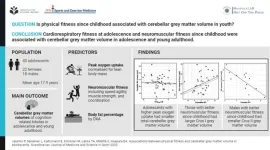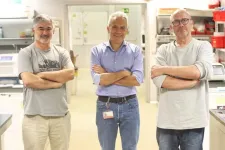(Press-News.org) DUARTE, Calif., Nov. 10, 2023 – In a breakthrough for human milk science, researchers at City of Hope, Los Angeles, have dosed the first patient in a Phase 2a clinical trial evaluating a novel therapy for blood cancer patients undergoing allogeneic hematopoietic stem cell transplantation. The investigational treatment, PBCLN-010 in combination with PBCLN-014, combines human milk sugars with a strain of bacteria found in the gut of nursing infants.
“Previous clinical trials of PBCLN-010 + PBCLN-014 have shown that it can safely and predictably control the gut microbiome in healthy adults,” said Greg McKenzie, PhD, VP Product Innovation, Prolacta Bioscience. “Stem cell transplant patients endure extreme health challenges, and we believe this therapy may provide a positive impact with safe, effective microbiome restoration, which could help improve outcomes of these critically ill patients.”
The randomized, open label, multicenter Phase 2a trial will evaluate the feasibility, efficacy, and safety of oral administration of PBCLN-010 (human milk oligosaccharides [HMOs]) in combination with PBCLN-014 (Bifidobacterium longum subspecies infantis [B. infantis]) in adult patients with blood cancers undergoing stem cell transplantation. The trial will evaluate how well B. infantis becomes part of the gut microbiome, as well as measure other changes in the microbiome over the course of six months, compared with current standard of care. Researchers will also monitor changes in biomarkers that may predict better patient outcomes.
“Patients undergoing stem cell transplant often have disruptions in their gut microbiome, including an increase in potentially disease-causing pathogens and an overall loss of diversity. This leaves patients prone to opportunistic infections and graft-versus-host disease, which can result in multi-organ attack and death. This Phase 2a study will measure how well the human milk-based therapy helps establish a healthy microbiome in patients with blood cancers, like it does naturally in the newborn gut,” said Karamjeet Sandhu, M.D., assistant professor, Department of Hematology & Hematopoietic Cell Transplantation at City of Hope, one of the largest cancer research and treatment organizations in the United States.
This Phase 2a trial is a continuation of research on the therapeutic benefits of the human milk-based microbiome therapy. Findings from two previous clinical trials using this approach were published in the journal Cell Host & Microbe (May 2022 and Sept. 2023) demonstrating that PBCLN-010 + PBCLN-014 can safely and predictably control the gut microbiome in healthy adults.1,2 This is the first time that a change of this magnitude was introduced into a subject microbiome, maintained in that subject, and then reversed in healthy adult subjects, indicating a high degree of control.
In addition to City of Hope, Los Angeles, leading stem cell transplant centers across the nation will be participating in the trial. Based on the severity of the disease and the size of the patient population, the company will file for and expects to receive orphan drug designation.
About Human Milk Oligosaccharides (HMOs) and B. infantis
Human breast milk contains high concentrations of a collection of approximately 200 structurally diverse sugars called human milk oligosaccharides (HMOs).3 Unlike the nutritional components of breast milk, HMOs are not metabolized as an energy source by the infant. Instead, HMOs serve to guide the growth of appropriate bacteria in the gut, which helps to train the infant’s immune system.4 In this way, HMOs support protective responses such as suppression of inflammation and improved intestinal barrier function to minimize infections.5
One species of “good” bacteria in the infant gut that is known to influence these protective responses is B. infantis, which is unique in its ability to utilize the HMOs in human breast milk. After infants are weaned from human milk, B. infantis levels decline into adulthood.6
Research, development, and early clinical trial support for PBCLN-010 and PBCLN-014 was provided by Prolacta Bioscience, a privately held global life sciences company dedicated to Advancing the Science of Human Milk.® The venture is now seeking strategic partners to continue development and pursue therapeutic market opportunities.
# # #
Media Contact:
Capwell Communications
media@capwellcomm.com
949-999-3303
References
Button et al. Precision modulation of dysbiotic adult microbiomes with a human-milk-derived synbiotic reshapes gut microbial composition and metabolites. Cell Host Microbe. 2023;31:1–16. doi: https://doi.org/10.1016/j.chom.2023.08.004
Button JE, et al. Dosing a synbiotic of human milk oligosaccharide and B. infantis leads to reversible engraftment in healthy adult microbiomes without antibiotics. Cell Host Microbe. 2022;30(5):712-725. doi:10.1016/j.chom.2022.04.001
Moukarzel S, Bode L. Human milk oligosaccharides and the preterm infant: a journey in sickness and in health. Clin Perinatol. 2017;44(1):193-207. doi:10.1016/j.clp.2016.11.014
Wicinski M, Sawicka E, Gebalski J, et al. Human milk oligosaccharides: health benefits, potential applications in infant formulas and pharmacology. Nutrients. 2020 Jan;12(1):266. doi: 10.3390/nu12010266 https://www.ncbi.nlm.nih.gov/pmc/articles/PMC7019891/
Chichlowski M, Shah N, Wampler JL, et al. Bifidobacterium longum subspecies infantis (B. infantis) in pediatric nutrition: current state of knowledge. Nutrients. 2020 Jun;12(6):1581. Published online 2020 May 28. doi: 10.3390/nu12061581 https://www.ncbi.nlm.nih.gov/pmc/articles/PMC7352178/
Arboleya S, Watkins C, Stanton C, et al. Gut bifidobacteria populations in human health and aging. Front Microbiol. 2016;7:1204. Published online 2016 Aug 19. doi: 10.3389/fmicb.2016.01204 https://www.ncbi.nlm.nih.gov/pmc/articles/PMC4990546/ END
With an eye toward a decade ahead that promises change, opportunity, and challenge, the University of Virginia on Friday launched its Futures Initiative to help plan for the next 10 years in higher education.
Over the next year, a group of thought leaders from across the University, known as the Futures Initiative Group, will examine the current drivers of change in academia, such as artificial intelligence and large language models like ChatGPT, while also looking ahead to the eventual impact of sensor technology, virtual classrooms, the Internet of Things, and myriad other technological changes.
The goal of the initiative—which was announced at Datapalooza 2023, an annual event ...
INDIANAPOLIS -- Regenstrief Institute, the International Medical Informatics Association (IMIA), the International Academy of Health Sciences Informatics (IAHSI) and the American Medical Informatics Association (AMIA) are hosting a mini-summit at the AMIA 2023 Annual Symposium to address how informatics can help resolve health issues caused by climate change. The event will bring together national and international experts to form an informatics infrastructure that will highlight and bring exposure to climate change's effects on health.
The event Mini-Summit 2023 -- Climate and health: How can informatics help? was planned because of the growing awareness around ...
HOUSTON ― Howard Meyers, of Dallas, Texas, a member of The University of Texas MD Anderson Cancer Center Board of Visitors (BOV), has committed $25 million to The University of Texas MD Anderson Cancer Center to establish the Meyers Institute for Oncology Nursing. The first of its kind, the Meyers Institute for Oncology Nursing will support and develop nurses throughout their careers by providing educational, professional and wellness-based resources tailored to cancer care nurses and nurse scientists. This ...
Some individuals with anti-Ro/SSA antibodies (anti–Sjögren's-syndrome–related antigen A autoantibodies, also called anti-Ro antibodies) have autoimmune diseases such as lupus or Sjögren's syndrome, but many have no symptoms. A clinical trial published in Arthritis & Rheumatology found that high levels of these antibodies in pregnant women are associated with fetal atrioventricular block (AVB), which occurs when inflammation and subsequent scarring prevent electric signals from the heart’s atria from reaching the ventricles. The disease ...
In a post hoc analysis of the phase 2 NOBILITY trial, researchers found that treatment with obinutuzumab—an antibody that targets a protein expressed on certain immune cells—was superior to placebo for preserving kidney function and preventing flares in patients with lupus nephritis, a kidney condition associated with the autoimmune disease lupus.
In the analysis, which is published in Arthritis & Rheumatology, compared with standard-of-care treatment alone, the addition of obinutuzumab to lupus nephritis treatment reduced the risk of developing a composite outcome of death, fall in kidney function, or treatment failure by 60%. Adding obinutuzumab ...
Statement Highlights:
The new American Heart Association PREVENTTM risk calculator estimates the 10- and 30-year risk of total cardiovascular disease for people aged 30 years and older.
The calculator estimates the risk of heart attack, stroke and — for the first time — heart failure. The equations are sex-specific and race-free, acknowledging that race is not a biological factor, and can include an index of social determinants of health.
This is the first risk calculator that combines measures of cardiovascular, kidney ...
Physical fitness since childhood is associated with cerebellar grey matter volume in adolescents. According to a recent study conducted at the University of Jyväskylä and the University of Eastern Finland, those who were stronger, faster and more agile, in other words, had better neuromuscular fitness since childhood, had larger Crus I grey matter volume in adolescence.
Despite the importance of the developing cerebellum on cognition and learning, the associations between physical fitness and cerebellar volume in adolescents have remained unclear. This study examined the associations ...
When scientists examined pellets from recycled plastic collected in 13 countries they found hundreds of toxic chemicals, including pesticides and pharmaceuticals.
The results are published in a study led by scientists at the University of Gothenburg.
Because of this, the scientists judge recycled plastics unfit for most purposes and a hinder in the attempts to create a circular economy.
Delegates, scientists and health and environmental advocates from around the world are traveling to Nairobi, Kenya for next week’s meeting of the third session of the Plastics Treaty Intergovernmental Negotiating ...
A significant breakthrough in developing a passive radiative cooling (PRC) material has been announced by researchers at City University of Hong Kong (CityU). The findings have just been published in the prestigious scientific journal Science titled “Hierarchically structured passive radiative cooling ceramic with high solar reflectivity.”
The material, known as cooling ceramic, has achieved high-performance optical properties for energy-free and refrigerant-free cooling generation. Its cost-effectiveness, durability and versatility make it highly suitable for commercialisation in numerous applications, particularly in ...
In a study published in the journal Circulation Research, researchers at the Centro Nacional de Investigaciones Cardiovasculares (CNIC) led by Dr. José Luis de la Pompa reveal the essential role of the protein neuregulin-1 (Nrg1) in the intricate transformation of the heart from its delicate primordial structure into a powerful pumping organ.
The findings not only highlight the pathways through which the human heart forms, but also suggest important directions for future medical advances. Commenting on the study, Dr. de la Pompa, head of the ...




